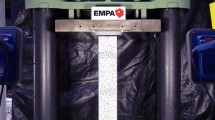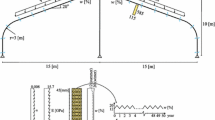Abstract
It is reported on results of a European research project on the DOL effect of structural sized glulam in tension perpendicular to the grain with special respect to different climates and volumes. The extensive experimental and theoretical investigations were performed jointly at VTT and FMPA — Otto-Graf-Institute in Finland and Germany, respectively. The test scheme comprised 80 curved beams and 180 prismatic tension specimens built-up of Nordic spruce laminations of grades C35 and C40 from one selected stand. The long-term investigations with stepwise loading regime were done in constant, cyclic and natural sheltered outdoor climates with constant stress volumes of 0.01 to 0.24 m3. As a major general result it can be stated that the findings from curved beams and tension specimens are well consistent. The results of ramp load reference and long term tests in constant climates validated the magnitudes of volume and pure time effect as specified in Eurocode 5. In variable climates a pronouncedly increased DOL effect was obtained which however is not bound to a specific material degradation but results from superimposed eigenstresses caused by the transient moisture gradients. Mean stress levels at failure normalized to ramp load strength in case of variable climates were in the range of 45%–66% with times to failure less than one month. The theoretical modeling of the long term damage forwarded that an effective stress concept based on transient Weibull stresses is a suitable approach to handle the non-linear superposition of applied loads and climate actions. The climate induced effective tension stress perpendicular to the grain can be in the range of 0.3 N/mm2 in case of severe service class 2 conditions. Wider cross-sections are relatively less influenced by moisture variations. With respect to design two alternative strategies to deal with the variable climate aspect are sensitive: introduction of additive climate bound design stresses or, more globally, a strength modification factor for accumulated time of loading, k mod, of about 0.55 for all load-duration classes in service class 2.
Zusammenfassung
Der Aufsatz berichtet über Durchführung und Ergebnisse eines europäischen Forschungsvorhabens zur Zeitstandfestigkeit von Brettschichtholz in Bauteilabmessungen bei Zugbeanspruchung rechtwinklig zur Faserrichtung unter besonderer Berücksichtigung unterschiedlicher Klimata und Volumina. Die umfangreichen experimentellen und theoretischen Untersuchungen wurden gemeinsam bei VTT in Finnland und bei der FMPA — Otto-Graf-Institut durchgeführt. Das Versuchsprogram umfaßte 80 gekrümmte Träger und 180 primatische Zugprüfkörper aus Fichtenlamellen nordeuropäischer Provenienz der Festigkeitsklassen C35 und C40 von einem ausgewählten Standort. Die Langzeituntersuchungen mit stufenweiser Belastung wurden in konstantem, zyklischem und natürlichem überdachtem Außenklima mit konstant beanspruchten Volumina von 0.01 bis 0.24 m3 vorgenommen. Als ein wichtiges allgemeines Ergebnis ist hervorzuheben, daß die Versuche mit den gekrümmten Trägern und mit den prismatischen Zugprüfkörpern weitgehend konsistente Ergebnisse erbrachten. Die Resultate der Kurzzeit-Referenzversuche und der Langzeitversuche in konstanten Klimata bestätigten die Größenordnung der in Eurocode 5 angegebenen Werte für den Volumen- sowie reinen Zeiteinfluß. Bei den variablen Klimata war eine deutlich ausgeprägtere Abminderung der Festigkeit zu verzeichnen, was jedoch nicht eine spezifische Materialzerrüttung darstellt, sondern aus überlagerten Eigenspannungen infolge transienter Feuchtegradienten resultiert. Die mittleren auf die Kurzzeitfestigkeit bezogenen Niveaus der Zeitstandfestigkeiten lagen bei den variablen Klimata im Bereich von 45% bis 66%, wobei die Versagenszeiten weniger als einen Monat betrugen.
Die theoretische Modellierung der Langzeitschädigung zeigt, daß ein sogenanntes effektives Spannungskonzept basierend auf transienten Weibull-Spannungen einen geeigneten Ansatz zur Erfassung der nichtlinearen Superposition von äußeren Lasten und klimatischen Einwirkungen darstellt. Die klimainduzierten effektiven Zugspannungen rechtwinklig zur Faserrichtung können im Falle ungünstiger Bedingungen innerhalb der Grenzen von Nutzungsklasse 2 in der Größenordnung von 0.3 N/mm2 liegen. Breitere Querschnitte verhalten sich bei Feuchteänderungen günstiger. Im Hinblick auf die Bemessung sind zwei alternative Vorgehensweisen zur Behandlung variabler Klimata sinnvoll: zum einen die Einführung zusätzlicher klimaabhängiger Bemessungsspannungen oder ein pauschaler Festigkeitsabminde-rungsfaktor für akkumulierte Lasteinwirkungszeiten, k mod, von circa 0.55 für alle Lasteinwirkungsklassen in Nutzungsklasse 2.
Similar content being viewed by others
References
Aicher S, Dill-Langer G (1996) Influence of cylindrical anisotropy of wood and loading conditions on off-axis stiffness and stresses of a board in tension perpendicular to the grain. Otto-Graf-Journal 7: 216–242, FMPA — Otto-Graf-Institute —, Stuttgart
Aicher S, Dill-Langer G (1997) DOL effect in tension perpendicular to the grain of glulam depending on service classes and volume. Proceedings CIB W18 Meeting 30, paper CIB-W18/30-9-1, Vancouver
Aicher S, Dill-Langer G (1998) Duration of load effect for glulam in tension perpendicular to the grain. Research Report, FMPA — Otto-Graf-Institute —, Stuttgart
Barrett JD (1974) Effect of size on tension perpendicular-to-grain strength of Douglas-Fir. Wood and Fiber 6: 126–143
Dill-Langer G, Aicher S (1997a) Influence of cyclic climate on DOL and creep of glulam in tension perpendicular to the grain. Proceedings International Conference on Wood-Water Relations: 421–435, Copenhagen
Dill-Langer G, Aicher S (1997b) Damage modelling of glulam in tension perpendicular to grain in variable climate. Proceedings CIB W18 Meeting 30, paper CIB W18/30-9-2, Vancouver
Gowda S, Ranta-Maunus A (1996) Duration of load effect on curved glulam beams. Part 1. Short term reference tests. VTT Research Notes 1741, Espoo
Gowda S, Kortesmaa M, Ranta-Maunus A (1998) Duration of load effect on curved glulam beams. Part 2. Long term load tests and analysis. VTT Publications 334, Espoo
Hanhijärvi A, Ranta-Maunus A (1996) Computational analysis of the effect of transverse anisotropy and annual ring pattern in cross-sections of curved beams on the size effect of strength. Proceedings European Workshop on Application of Statistics and Probabilistics in Wood Mechanics (in press), Bordeaux
Madsen B (1975) Duration of load tests for wood in tension perpendicular to grain. Forest Products Journal 25: 48–53
Mindess S, Madsen B, Barrett JD (1979) Rate of loading and duration of load tests on Douglas-Fir in tension perpendicular to the grain. Proceedings of the 1st Conference of Wood Fracture: 143–157, Banff
Ranta-Maunus A (1990) Impact of mechano-sorptive creep to the long-term strength of timber. Holz Roh- und Werkstoff 48:67–71
Ranta-Maunus A, Gowda S (1994) Curved and cambered glulam beams. Part 2. Long term tests under cyclically varying humidity. VTT Publications 171, Espoo
Ranta-Maunus A (1995) Creep and effects of moisture in timber. In Holzbauwerke nach Eurocode 5, STEP 3, Arbeitsgemeinschaft Holz e. V., Düsseldorf
Ranta-Maunus A (1996) The influence of changing state of stress caused by mechano-sorptive creep on the duration of load effect. Proceedings International Conference on Wood Mechanics: 187–201, Stuttgart
Author information
Authors and Affiliations
Additional information
This research was performed in the frame of a European project supported by EU grant A1R2-CT94-1057 which is gratefully acknowledged.
Rights and permissions
About this article
Cite this article
Aicher, S., Dill-Langer, G. & Ranta-Maunus, A. Duration of load effect in tension perpendicular to the grain of glulam in different climates. Holz als Roh- und Werkstoff 56, 295–305 (1998). https://doi.org/10.1007/s001070050323
Issue Date:
DOI: https://doi.org/10.1007/s001070050323




